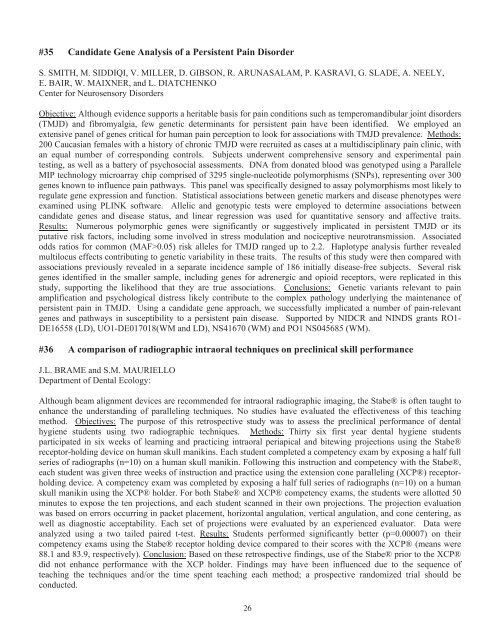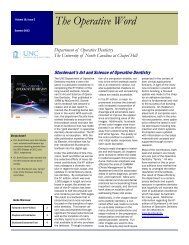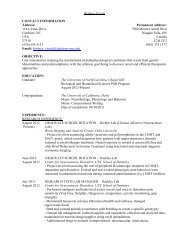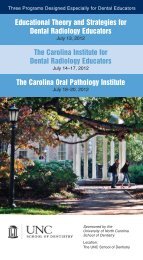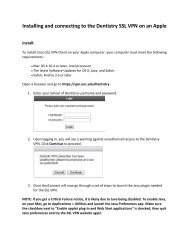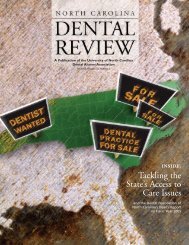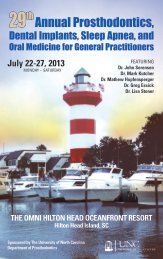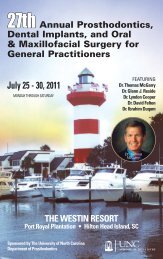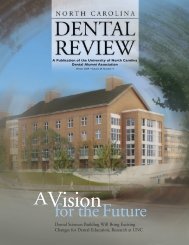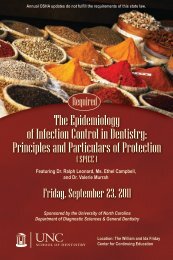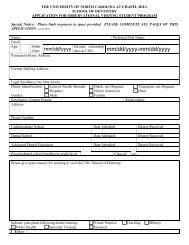UNC School of Dentistry - The University of North Carolina at ...
UNC School of Dentistry - The University of North Carolina at ...
UNC School of Dentistry - The University of North Carolina at ...
Create successful ePaper yourself
Turn your PDF publications into a flip-book with our unique Google optimized e-Paper software.
#35 Candid<strong>at</strong>e Gene Analysis <strong>of</strong> a Persistent Pain DisorderS. SMITH, M. SIDDIQI, V. MILLER, D. GIBSON, R. ARUNASALAM, P. KASRAVI, G. SLADE, A. NEELY,E. BAIR, W. MAIXNER, and L. DIATCHENKOCenter for Neurosensory DisordersObjective: Although evidence supports a heritable basis for pain conditions such as temperomandibular joint disorders(TMJD) and fibromyalgia, few genetic determinants for persistent pain have been identified. We employed anextensive panel <strong>of</strong> genes critical for human pain perception to look for associ<strong>at</strong>ions with TMJD prevalence. Methods:200 Caucasian females with a history <strong>of</strong> chronic TMJD were recruited as cases <strong>at</strong> a multidisciplinary pain clinic, withan equal number <strong>of</strong> corresponding controls. Subjects underwent comprehensive sensory and experimental paintesting, as well as a b<strong>at</strong>tery <strong>of</strong> psychosocial assessments. DNA from don<strong>at</strong>ed blood was genotyped using a ParalleleMIP technology microarray chip comprised <strong>of</strong> 3295 single-nucleotide polymorphisms (SNPs), representing over 300genes known to influence pain p<strong>at</strong>hways. This panel was specifically designed to assay polymorphisms most likely toregul<strong>at</strong>e gene expression and function. St<strong>at</strong>istical associ<strong>at</strong>ions between genetic markers and disease phenotypes wereexamined using PLINK s<strong>of</strong>tware. Allelic and genotypic tests were employed to determine associ<strong>at</strong>ions betweencandid<strong>at</strong>e genes and disease st<strong>at</strong>us, and linear regression was used for quantit<strong>at</strong>ive sensory and affective traits.Results: Numerous polymorphic genes were significantly or suggestively implic<strong>at</strong>ed in persistent TMJD or itsput<strong>at</strong>ive risk factors, including some involved in stress modul<strong>at</strong>ion and nociceptive neurotransmission. Associ<strong>at</strong>edodds r<strong>at</strong>ios for common (MAF>0.05) risk alleles for TMJD ranged up to 2.2. Haplotype analysis further revealedmultilocus effects contributing to genetic variability in these traits. <strong>The</strong> results <strong>of</strong> this study were then compared withassoci<strong>at</strong>ions previously revealed in a separ<strong>at</strong>e incidence sample <strong>of</strong> 186 initially disease-free subjects. Several riskgenes identified in the smaller sample, including genes for adrenergic and opioid receptors, were replic<strong>at</strong>ed in thisstudy, supporting the likelihood th<strong>at</strong> they are true associ<strong>at</strong>ions. Conclusions: Genetic variants relevant to painamplific<strong>at</strong>ion and psychological distress likely contribute to the complex p<strong>at</strong>hology underlying the maintenance <strong>of</strong>persistent pain in TMJD. Using a candid<strong>at</strong>e gene approach, we successfully implic<strong>at</strong>ed a number <strong>of</strong> pain-relevantgenes and p<strong>at</strong>hways in susceptibility to a persistent pain disease. Supported by NIDCR and NINDS grants RO1-DE16558 (LD), UO1-DE017018(WM and LD), NS41670 (WM) and PO1 NS045685 (WM).#36 A comparison <strong>of</strong> radiographic intraoral techniques on preclinical skill performanceJ.L. BRAME and S.M. MAURIELLODepartment <strong>of</strong> Dental Ecology:Although beam alignment devices are recommended for intraoral radiographic imaging, the Stabe® is <strong>of</strong>ten taught toenhance the understanding <strong>of</strong> paralleling techniques. No studies have evalu<strong>at</strong>ed the effectiveness <strong>of</strong> this teachingmethod. Objectives: <strong>The</strong> purpose <strong>of</strong> this retrospective study was to assess the preclinical performance <strong>of</strong> dentalhygiene students using two radiographic techniques. Methods: Thirty six first year dental hygiene studentsparticip<strong>at</strong>ed in six weeks <strong>of</strong> learning and practicing intraoral periapical and bitewing projections using the Stabe®receptor-holding device on human skull manikins. Each student completed a competency exam by exposing a half fullseries <strong>of</strong> radiographs (n=10) on a human skull manikin. Following this instruction and competency with the Stabe®,each student was given three weeks <strong>of</strong> instruction and practice using the extension cone paralleling (XCP®) receptorholdingdevice. A competency exam was completed by exposing a half full series <strong>of</strong> radiographs (n=10) on a humanskull manikin using the XCP® holder. For both Stabe® and XCP® competency exams, the students were allotted 50minutes to expose the ten projections, and each student scanned in their own projections. <strong>The</strong> projection evalu<strong>at</strong>ionwas based on errors occurring in packet placement, horizontal angul<strong>at</strong>ion, vertical angul<strong>at</strong>ion, and cone centering, aswell as diagnostic acceptability. Each set <strong>of</strong> projections were evalu<strong>at</strong>ed by an experienced evalu<strong>at</strong>or. D<strong>at</strong>a wereanalyzed using a two tailed paired t-test. Results: Students performed significantly better (p=0.00007) on theircompetency exams using the Stabe® receptor holding device compared to their scores with the XCP® (means were88.1 and 83.9, respectively). Conclusion: Based on these retrospective findings, use <strong>of</strong> the Stabe® prior to the XCP®did not enhance performance with the XCP holder. Findings may have been influenced due to the sequence <strong>of</strong>teaching the techniques and/or the time spent teaching each method; a prospective randomized trial should beconducted.26


